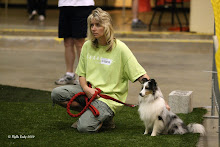She talked about spaying and neurtering dogs. She recommends that you dont fix your dog until they are 14 months old. Personally she doesnt think you should fix a male dog but her females she fixes at 14 months due to the risk of mammary cancer and pyometra. I , Diana, have been struggling with spaying Miley or not. Ive been worried that she needs these hormones to keep up muscle building and strenght. I do have an appt. for Miley to be spayed on Wednesday. The deciding factor was, what if Mickey and Guiness get in a fight when Miley goes into heat. I would never forgive myself. So I asked the question at the seminar about when women have hysterectomies or go thur menapause, that they loose muslce mass and bone density ect.. She said dogs are different than people because the secret some of their hormones from their adrenal glands. So they dont have problems like that. So now I feel better about having Miley spayed. She also talked about the delay in growth plates when you fix your dog by 6 months. She feels that if you fix your dog early that they shouldnt be jumping until they are 22 months because of the delay in growth plate closure. Wow!
Next she talked about the height to weight ratios of your dog and how they effect the wear and tear injuries of your dog. You take your dogs weight and divide it by there height. Ratios:
> 3.5 Danger zone
2.0 - 3.5 Be Careful
<2.0 easy street
If you keep your dog lean you lower their ratio. Dogs with low ratios have less injuries and rehab faster. If your dog is in the danger zone then you should only show on soft ground and no full height jump training.
Next we talked about structure. Rear angulation: She talked about measuring rear angulation. She put everyone in 2 groups and each group felt all the dogs and they voted on which dog had the most rear angulation. She told us how to see rear angulation. I cant really show it to you hear but you can see it in her book called, "The Agility Advantage" I wasnt good about being able to see and feel body structure. Dogs with more rear angulation have a longer stride but are less stable in the rear. You want to look for moderation in the rear. Most dogs in the breed ring have over angulated rears. We went through video of Westminster dog show and watched the dogs gait. Many of the dogs were crabbing, this is when there rear is to the side of the front. At a trot, the back over lap the front feet, this is also crabbing. So this is bad because each side of the body is working differently.
Front: Which breeds have the straightest shoulders? Shelties. Dogs with straight fronts hold their heads up. So many people breed for straight fronts because it keeps the head up in the ring. She showed us how to evaluate fronts (shoulders). Again we were broken in two groups. One shelite was in each group. ( most of the dogs there were Golden Retrievers). So we voted again. O'course the shelties both had the straightest fronts. Many times in obedience dogs get front left leg lameness because of putting their heads up and looking at their owner. By turning this way they are putting more weight on their left front leg. Its important to have a angulated front because the front take 65% of the dogs weight. So she says if you have to pick a dog its better to take the dog with a good front and not so good rear ( if you have to pick). Dogs with good shoulders have longevity and less injuries. Common injury with straight shoulders is Medial shoulder instability. Also you dog needs to be fit, have good muscles, to hold the angles in place.
Other things: Tails are good because the help counter balance. So if something happens, like falling off the dogwalk they maybe able to counter balance with the tail and stay on. Dew claws are important and should not be removed. Dogs without dew claws tend to get carpal tunnel arthritis. When cantering, ( the gait use in agility) dogs use their dew claws to turn which stabilises the leg.
Gaits: When a dog trots and you view them from the front or back their legs should make a "V".
So we watched all the dogs trot up and down and decided if they were in a "V". Also their front legs should extend out to there nose when they trot. Miley's front legs were in a "v" but she crossed them slightly. But Chirs felt this was because she was still young and just needed to mature and build her front chest muscle. In the rear Miley was slightly cow hocked. ( which she was at 8 weeks so I figured she would be) Cow hocks help a dog lie down and get up faster and also turn faster. So in the breed ring the boarder collie is allowed to be slightly cow hocked. But that dog may not win, so many times it is bread out of them.
Dogs that are out of balance with front and rear will pace. She did the corn starched test on one dog. On the black mat, she put corn starch on the front feet and had the dog trot straight down the mat. Then she measured the back of one foot to the back of the next foot. It should be about equal with each foot measurement. It can show you if the dog is favoring a side or if the foot print is to light then they aren't putting much pressure on that foot. There was a dog that paced and she showed us how she retrains a dog not to pace but trot. She states pacing can happen from making the dog transition to slowly between gaits. Retraining the gait is also in her book and its to long for me to go through. It will take about 2 months to retrain a gait. Just a note: dogs that haven't learned to change gaits easily, will be more likely to fall off the dog walk. They usually use 3 gaits to go over the dog walk. Cantor, trot then walk down.
More tomorrow.






2 comments:
Cool. You got lots of great information! Thanks for sharing!
Great stuff!!! Thank you so much for posting this. We've read her book and absolutely love it.
BTW my ratio is 1.0967 and Gracie's is 1.459, guess we're good to go! That's reassuring!
Looking forward to more info!
Woofs, Johann
Post a Comment